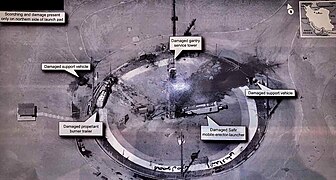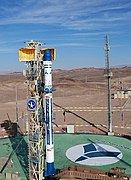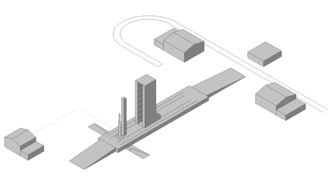Semnan Space Center
 | |
| Agency overview | |
|---|---|
| Formed | 1 February 2004 |
| Type | Space agency |
| Headquarters | Semnan, Semnan Province 35°14′05″N 53°55′20″E / 35.2346°N 53.9221°E |
| Administrator | Iranian Space Agency |
| Primary spaceport | Imam Khomeini Space Launch Terminal |
| Owner | Iranian Space Agency |
| Website | isa |
| Location within Iran | |
Semnan Space Center (Persian:مرکز فضایی سمنان) is the primary Iranian spaceport, located 50 km southeast of the city of Semnan in the north of the country.
History
Media attention on the space center began when Iranian authorities announced their intent to launch an artificial satellite within weeks on 16 August 2008. On 17 August 2008, Iran proceeded, as preannounced, with the second test launch of a three stage Safir SLV from a site 35°14′5″N 53°55′15″E / 35.23472°N 53.92083°E south of Semnan in the northern part of the Dasht-e-Kavir desert. Reza Taghizadeh, head of the Iranian Aerospace Organization, told state television "The Safir (Ambassador) satellite carrier was launched today and for the first time we successfully launched a dummy satellite into orbit". As reported in late 2009 and early 2010, a new, larger launch pad was under construction at 35°15′30″N 53°57′17″E / 35.25833°N 53.95472°E.
Launch sites
Circular launch platform
The Circular Launch Platform is the oldest launch pad and also recognizable by the light blue background with the original logo of the Iran Space Agency (ISA).The platform has a simplified character and consists of a leveled terrain with a circular asphalted section of a diameter of 65 m, at the center of which is a service tower.
-
Circular Launch Platform after a launch failure.
-
Safir rocket on the Circular Launch Platform.
-
Safir rocket on the Circular Launch Platform.
Main Launch Platform
The Main Launch Platform (Imam Khomeini Space Launch Terminal) is located at the east of the complex on a specially enclosed octagonal area measuring 900 x 660 m and covering an area of 51.4 ha, representing the largest single element of the new space center. The units are accessed by a road from the northwest, which is within the perimeter of the three rays and forms two main inner zones – almost completely built lower and newly initiated upper (state of 2015). The lower zone consists of spacious launching platforms with towers and four larger compartments for installation and storage.
-
An axonometric sketch of the Main Launch Platform, left to right:
- fuel tank (piped drains)
- launch ramp with Simorgh
- auxiliary service facilities. -
Simorgh launching from Main Launch Platform, 2017.
-
Simorgh launcher with the Payam satellite at Main Launch Platform, 2019
-
Simorgh launching from the Main Launch Platform, 2019.
| Map of the Semnan Space Center | |
|---|---|
 |
Legend: Road communication Main facilities and installations Inclination launch (55°-66°) Installations:(A) - Antennas for communications (35°11′34″N 53°56′21″E / 35.19278°N 53.93917°E) (E) - Distribution substations (35°14′42″N 53°53′48″E / 35.24500°N 53.89667°E) (K) - Circular launch pad (35°14′5″N 53°55′15″E / 35.23472°N 53.92083°E) (L) - Main launch pad (35°14′14″N 53°57′0″E / 35.23722°N 53.95000°E) (M) - Drive mounting rocket (35°14′53″N 53°54′46″E / 35.24806°N 53.91278°E) (O) - Operations Center (35°14′41″N 53°56′6″E / 35.24472°N 53.93500°E) (P) - Polygon ballistic missiles (35°13′46″N 53°51′58″E / 35.22944°N 53.86611°E) (T) - Test center for rocket motors (35°15′31″N 53°57′15″E / 35.25861°N 53.95417°E) (U) - Administrative Center (35°15′15″N 53°54′0″E / 35.25417°N 53.90000°E) (V) - Military administrative and technical center (35°13′21″N 53°53′45″E / 35.22250°N 53.89583°E) |
Launch history
| Date | Carrier rocket | Payload | Pad | Outcome | Note |
|---|---|---|---|---|---|
| November 2, 2006 | Kavoshgar-1 (A) | No Payload | mobile | Success | Atmospheric flight (v = 10 km) |
| February 25, 2007 | Kavoshgar-1 | mobile | Success | First Mesosphere flight | |
| February 4, 2008 | Kavoshgar-1 | No Payload | mobile | Success | First flight above Kármán line |
| August 16, 2008 | Safir-1 | circular | Success | First Iranian object in Orbit | |
| November 26, 2008 | Kavoshgar-2 (B) | Empty bio capsule | mobile | Success | Atmospheric flight (v = 40 km) |
| February 2, 2009 | Safir-1 | circular | Success | First operational Iranian Satellite | |
| February 3, 2010 | Kavoshgar-3 (B) | mobile | Success | Atmospheric flight (v = 55 km) | |
| March 15, 2011 | Kavoshgar-4 (C) | Empty bio capsule | mobile | Success | Suborbital flight (v = 135 km) |
| June 15, 2011 | Safir-1A | circular | Success | Operating satellite | |
| September 15, 2011 | Kavoshgar-5 (C) | mobile | Failure | Suborbital flight (v = 120 km) | |
| February 3, 2012 | Safir-1B | circular | Success | Operating satellite | |
| May 23, 2012 | Kavoshgar-6 (C) | mobile | Failure | Suborbital flight (v = 120 km) | |
| January 28, 2013 | Kavoshgar-7 (C) | mobile | Success | Suborbital flight (v = 120 km) | |
| December 14, 2013 | Kavoshgar-8 (D) | circular | Success | Suborbital flight (v = 120 km) | |
| February 2, 2015 | Safir-1B | circular | Success | Satellite orbited for 24 days prior to re-entry | |
| April 19, 2016 | Simorgh | No Payload | Main | Success | Suborbital flight |
| July 27, 2017 | Simorgh | No Payload | Main | Failure | Test flight; failure shortly after liftoff |
| January 15, 2019 | Simorgh | Main | Failure | Third stage failed | |
| February 5, 2019 | Safir | Main | Failure | Launch failure | |
| February 9, 2020 | Simorgh | Main | Partial failure | Satellite fails to reach orbit | |
| 31 January or 1 February 2021 | Zuljanah | Test payload | circular | Success | Successful first test flight of Zuljanah. Sub-orbital. Apogee 500 km. |
| June 12, 2021 | Simorgh | Unknown payload | Main | Failure | Failed to reach orbit. |
| December 30, 2021 | Simorgh | 3 unknown payloads | Main | Failure | Iranian state media reported a successful flight, but no objects were detected in orbit following this launch. Reported apogee: 470 km (290 mi). |
| June 26, 2022 | Zuljanah | circular | Success | Successful second test flight of Zuljanah. Sub-orbital. | |
| December 6, 2023 | Salman | Bio-capsule | circular | Success | Successful maiden flight of Salman. Sub-orbital (v = 130 km). |
| January 28, 2024 | Simorgh | 3 satellites | Main | Success | First successful orbital flight of Simorgh. Carried the Hatef-1, Keyhan-2 and Mahda satellites. |
| December 6, 2024 | Simorgh | Fakhr-1 military Communications Satellite, one research satellite | Main | Success | First Successful launch equipped with Saman-1 space tug, inserting two satellites into orbit with an apogee of 410km and perigee of 300 kilometers. |
References
- ^ "伊朗将于下周发射自主生产的卫星". 伊通社. August 16, 2008. Archived from the original on September 12, 2008. Retrieved August 18, 2008.
- ^ "Iran says it has put first dummy satellite in orbit". Reuters. Retrieved January 27, 2023.
- ^ "Massive Construction Visible at Iran's Missile & Space Center at Semnan". Archived from the original on October 25, 2017. Retrieved April 1, 2018.
- ^ "Imagery of Construction of New Launch Site in Iran | Scoop News". www.scoop.co.nz.
- ^ ARI (December 17, 2014). تاریخچه کاوشگر ایرانی: پژوهشکده سامانههای فضانوردی و یکدهه سابقه پرتاب محمولههای فضایی (in Persian). Tehran: پژوهشکده سامانه های فضانوردی. Archived from the original on December 19, 2013. Retrieved December 21, 2015.
- ^ Hildreth, Steven A. (December 6, 2012). Iran's Ballistic Missile and Space Launch Programs. CRS report for Congress. Vol. R42849. Washington, DC: Congressional Research Service (CRS), Library of Congress. pp. 13–14, 32, 39–44. i 57–58. Retrieved January 27, 2023.
- ^ Harding, Robert C. (2013). Space Policy in Developing Countries: The Search for Security and Development on the Final Frontier. Space Power and Politics. Milton Park, Abingdon, Oxfordshire; New York: Routledge. p. 131. ISBN 9780415538459. OCLC 773023787.
- ^ Hansen, Nick (November 21, 2012). "Rocket science – Iran's rocket programme". Jane's Intelligence Review. 24 (11).
- ^ Krebs, Gunter D. "Fajr". Gunter's Space Page. Retrieved January 28, 2023.
- ^ Eshel, Tamir (April 24, 2016). "Simorgh First Launch – an Iranian Success or Failure?". Qadima: Defense Update. Retrieved July 28, 2017.
- ^ Krebs, Gunter. "Simorgh (Safir-2)". Gunter's Space Page. Retrieved December 15, 2017.
- ^ Nadimi, Farzin (August 1, 2017). "Iran's Space Program Emerges from Dormancy". The Washington Institute of Near East Policy. Retrieved January 28, 2023.
- ^ "Gunter's Space Page". Retrieved January 15, 2019.
- ^ "Simorgh (Payam)". Retrieved January 15, 2019.
- ^ "Iranian Satellite Launched But Fails To Reach Earth's Orbit". Radio Free Europe/Radio Liberty. Retrieved February 9, 2020.
- ^ Cohen, Zachary; Liebermann, Oren (June 23, 2021). "Pentagon tracked failed Iranian satellite launch and new images reveal Tehran is set to try again". CNN. Retrieved June 23, 2021.
- ^ Graham, William (December 30, 2021). "Iran's Simorgh rocket falls short of orbit with three payloads aboard". NASASpaceFlight. Retrieved December 30, 2021.
- ^ Karimi, Nasser; Debre, Isabel (June 26, 2022). "Iran launches rocket into space as nuclear talks to resume". AP News. Retrieved June 26, 2022.
- ^ Tasnim News Agency [@Tasnimnews_Fa] (June 26, 2022). "The second research launch of #Zuljanah_rocket. Defense Ministry spokesman: Zuljanah's three-stage satellite is technically competitive with modern-day satellite rockets, which have two stages of solid propulsion and one stage of liquid propulsion. The launch of the rocket on Zuljanah was carried out with the aim of sub-orbit" (Tweet) – via Twitter.
- ^ "Iran successfully launches newest bio-space capsule". Mehr News Agency. December 6, 2023. Retrieved December 6, 2023.
- ^ "Iran Puts 3 Indigenous Satellites into Orbit". Fars News Agency. January 28, 2024. Retrieved January 28, 2024.
- ^ "Iran launches heaviest space payload into orbit: media". Voice of America. December 6, 2024. Retrieved December 6, 2024.







